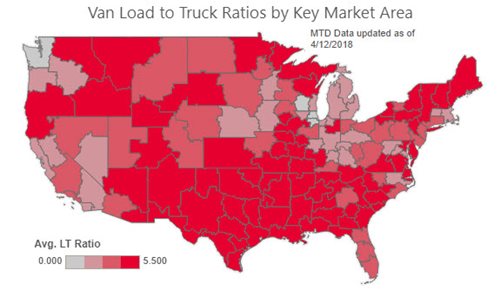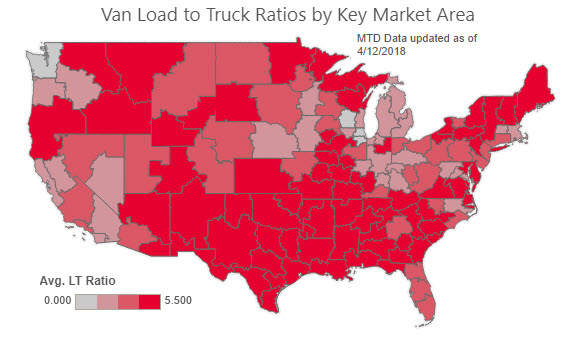We write about the load-to-truck ratio a lot on this blog and on DAT Trendlines, but we don't always explain it. So I'm going to give this a whirl, and explain how it's used as a guide to see if freight rates are trending up or down. Below are some of the questions we get asked the most about the ratios. If you have more questions, please post them in the comments, and I'll answer those, too.
What is the load-to-truck ratio?
The load-to-truck ratio is the number of load posts on DAT load boards divided by the number truck posts. When there are a lot of load posts, or there are very few truck posts, or both, the load-to-truck ratio goes up. If there aren't so many loads, or there are a lot of trucks available, the ratio goes down. Typically, the load-to-truck ratio is highest for flatbeds, followed by reefers, and then vans with the lowest ratio of the three. That's because it's hardest for brokers to find the right flatbed equipment, and there are more vans available than flatbeds and reefers combined.
Why is the load-to-truck ratio important?
The load-to-truck ratio describes the balance between freight availability and truckload capacity on the spot market, and it's updated constantly. Changes in the ratio often signal a change in freight rates, and because the ratio is refreshed so often, it's usually the first indicator of a change in market conditions. Over the years, trends in the load-to-truck ratio have shown a correlation of 89% to 91% with spot market rate trends. So, even though the ratio is not perfect, it provides useful, timely information about the market for freight transportation.

Is the load-to-truck ratio different in each state or city? How often does it change?
DAT reports the load-to-truck ratio by equipment type nationwide, by state, or by key market area (the freight market surrounding a city) for a day, a week or a month. You can view the outbound load-to-truck ratios for 135 key market areas on a DAT Hot Market Map like the one below, which summarizes the trends for the first two weeks of April. The whole southern band of states (except Florida) is deep red now, which means the load-to-truck ratios are above 5.5-to-1. Ratios are surprisingly high in the Northeast, as well. You can see a one-day Hot Market Map in DAT Power or DAT RateView, showing the previous business day, or you can choose your own time frame if you subscribe to DAT Data Analytics Services.
Will I get a better rate in a market where the load-to-truck ratio is high?
You won't always get a better rate in a market with a high load-to-truck ratio. You also need to look at the actual number of loads and trucks posted. For example, Medford, in Southern Oregon, often has a high load-to-truck ratio. The outbound ratio in Los Angeles is usually much lower, but there can be more than three times as many loads posted in L.A. than in Medford. Plus, the Medford market covers a much bigger area on the map, so you could have some deadhead for pickup and delivery. Upside: Rates are typically higher heading into a quiet market like Medford, to compensate for the extra time and effort it could take to find a load back out.
What can the load-to-truck ratio tell me about rate trends?
When the load-to-truck ratio goes up, rates usually do, too. The trend is more important than the actual number. Looking at the graph below, you can see that the load-to-truck ratio for vans rose steadily from March 2017 through January 2018, and national average van rates followed the same pattern.

How does the load-to-truck ratio help me to choose my next load?
Load-to-truck ratios can help you to understand where to position your truck to pick up the next load. For example, it's typically easier to find loads out of Dallas than Houston, and Dallas loads usually paid better, too, but that's not the case now. The load-to-truck ratio was 5.6 in Houston last week, compared to 2.5 in Dallas. So if you're heading to Texas, you could be better off taking a load to Houston, where it's easier to find a load back out. On the other hand, if you're already in Dallas, you can find a load to Houston, and then look for another load to build a triangular route, or TriHaul. Or just go back and forth between Dallas and Houston a few times per week, for an average of $2.50 per mile on the 480-mile roundtrip.
How can I believe the load-to-truck ratios when they're so high?
Load-to-truck ratios can get really high when there's an urgent demand for trucks. Brokers may compete against each other to secure a truck, or they may refresh their load posts or even re-post them if they're not covered fast enough. At the same time, when there are so many loads to choose from, carriers are less likely to post their trucks. So the load-to-truck ratio keeps rising. Think of the load-to-truck ratio as pressure gauge — more like a barometer than a thermometer — that helps you to compare different markets or time periods. Is there more pressure in one city than another? Is there more pressure today than there was last week? The trend is more important than the actual number. And when the load-to-truck ratio goes up, rates usually follow.
Freightliner’s Team Run Smart is partnering with DAT to offer a special on the TruckersEdge load boardto its members. Sign up for TruckersEdge today and get your first 30 days free by signing up at www.truckersedge.net/promo717 or entering “promo717” during sign up.
* This offer is available to new TruckersEdge subscribers only
About TruckersEdge®, powered by DAT®
TruckersEdge® Load Board is part of the trusted DAT® Load Board Network. DAT offers more than 68 million live loads and trucks per year. Tens of thousands of loads per day are found first or exclusively on the DAT Network through TruckersEdge.
This article was originally featured on DAT.com.